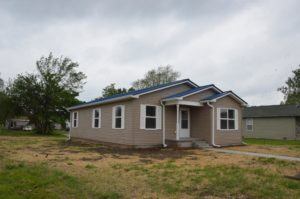A new cold storage unit for a food bank to distribute frozen food. Rehabilitation of older homes and community centers. Funds to help a domestic violence shelter make ends meet.
Those are just some of the ways Indiana’s cities and towns benefit from federal grants for community and housing development – and why leaders say Congress continuing its long-time support for those funds is vital.
The $3 billion in Community Development Block Grant funds, with $60 million routed to Indiana alone, support a wide-range of services for low-and-moderate income Hoosiers. Absent the funds, needs of Indiana’s most vulnerable residents would go unmet and transformative projects would face delays.
In the days ahead, Aim will spotlight the positive impacts Community Development Block grants and other U.S. Department of Housing and Urban Development grants have had on our communities.
‘That is the only way we could have survived’
For most of the homes built by Wabash Valley Habitat for Humanity, the new owners have benefited from down payment assistance made possible by a federal program called HOME.
Eligible homebuyers receive $35,000 in assistance to lower their mortgage, which allows them to pay off their house at a faster pace. And the funding from the HOME Investment Partnerships Program frees up seed money for the next Habitat build.
“That is the only way we could have survived,” said Annette Houchin, executive director of Wabash Valley Habitat for Humanity, of the federal dollars they receive from Terre Haute. “The Department of Redevelopment has played an integral part in keeping us above water.”
Along with the mortgage help, a majority of the lots used for Habitat houses are donated by the city.
In 2016, Terre Haute received $1.75 million between the HOME and Community Development Block Grant programs.
The city uses a large portion of its Community Development Block Grant funds for infrastructure replacement in income-eligible neighborhoods. Other major projects entail rehabilitating older housing stock and community centers to demolishing blighted structures.
That’s critical for Terre Haute, which has one of the highest percentages of older housing stock in the state. Most of the city was developed between 1890 and 1920.
“Without the funds, many of these areas would just not receive the attention that they need,” said Phil Kesner, the city’s grants and planning administrator.
 The federally-backed program also helps residents reinvest in their homes and allows the city to partner with non-profits to construct new housing or leverage private funds to build new rental units.
The federally-backed program also helps residents reinvest in their homes and allows the city to partner with non-profits to construct new housing or leverage private funds to build new rental units.
“We are trying to improve the quality of the neighborhoods, trying to improve the quality of life for residents in these areas and provide safe, decent, affordable housing that is energy efficient. Without these funds, it would extremely limit the city’s ability to develop housing for people that have limited income,” Kesner said.
A key benefit of the Community Development Block Grant program is that it allows communities to tailor funds to their specific needs, Kesner said.
“It adds to other improvements that the city is undertaking with its local resources,” Kesner said. “This is an extremely positive program.”
